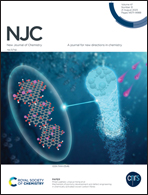Hydrothermal fabrication of Sn/SnO/SnO2 hybrid nanocomposites as highly reliable anodes for advanced lithium-ion batteries†
Abstract
A novel hybrid nanocomposite (HNC) material consisting of Sn, SnO, and SnO2 was successfully synthesized via a modified hydrothermal technique using urea and SnCl2 as the precursors. The Sn/SnO/SnO2 ratio and the structure of the HNC, which can easily be controlled by varying the concentration of the SnCl2 salt, greatly influence the electrochemical properties of the HNC electrodes when applied as lithium-ion battery anode materials. The highest electrochemical performance was achieved when the concentration of SnCl2 was 22.5 × 10−3 M, denoted as sample M3. For instance, the M3 electrode delivered a reversible capacity of 1056 mA h g−1 at 0.1 A g−1 after 100 cycles. Its impressive electrochemical performance was achieved due to the nano-size of Sn/SnO/SnO2 particles, the highly reversible conversion reaction between the tin oxides and Li2O, and a suitable ratio of the components in the M3 sample. This synergistic effect can maintain the stability of the electrode structure and improve the pseudo-capacitance process, leading to excellent Li-ion storage and highly durable cycling of the HNCs.



 Please wait while we load your content...
Please wait while we load your content...